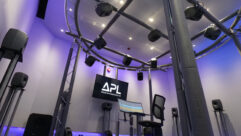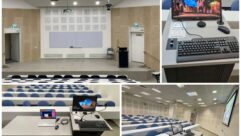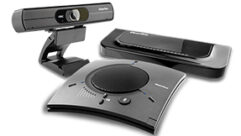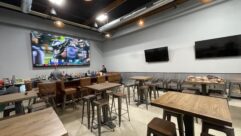UPGRADING FOR SIMPLICITY
May 1, 2000 12:00 PM,
Daniel Goldich
Converting the videowall signage at the Warner Brothers Studio Stores todigital for enhanced reliability and ease of maintenance.
After rolling out 200 outlets and winning numerous store design awards overthe past eight years, Warner Brothers Studio Stores (WBSS) continue toboast one of the most successful and effective videowalls and sound systemsin retail. WBSS is among the first leading retailers to appreciate thevalue of deliberate, concise videowall show programming.
One of the first to launch a rollout of ultra-themed retail outlets with astate-of-the-art video cube system in 1991, WBSS prolongs its stay on thecutting edge with an all-new digital video control system designed byInnovative Design Technologies. Intended specifically for the automatedshow control sector, SmartServer is a single-box hardware and softwaresolution for show control. SmartServer serves one to four synchronizedsources of MPEG-2 video while providing time code and accurate show controlover all the leading videowall processors and a host of other devices.
The existing systems, originally installed for WBSS over a seven-yearperiod, were made up of four distinct design variations using threeseparate software systems and four different videowall processors. All ofthe systems were based upon four video laserdisc players each containing 30minutes of material, a serial port sharing device and an A-V switcher. Thesound systems, although varied over the years by manufacturer, weredesigned with a distributed loudspeaker system using approximately 20 JBLControl 1 loudspeakers with Yamaha subwoofers and, later, Tannoy CPA-5loudspeakers with Triad subwoofers. The audio front end contained aVCA-controllable mixer, 1/3-octave EQs and power amps.
With the videowall system, the objective was not only to promote WarnerBrothers content, but also to entertain and inform the customers. Placed atthe back of the store, the videowalls play high-energy clips enhanced bycontent-sensitive videowall programming. This setup allowed WBSS to drawconsumers all the way through the merchandise aisles and assist in keepingthem in the store longer. Extremely effective for WBSS, this strategycontributed to a trend of retailers’ including video as a part of thein-store design scheme.
The original system, designed by Background Engineers, was a hybridconsisting of Pioneer video cubes, an Electro-sonic Picbloc videowallprocessor and C-through software. This was mixed with low-cost,off-the-shelf hardware to minimize the cost of the control system.Additional software was custom written to automate the power cycle and showupdates and system diagnostics. After the first 20 installations, Imtechintroduced the Ultra videowall processor in 1992,which delivers a superiorinterpolated image for a fraction of the cost. At this point, the onlything missing was software to control the new processor. For the costsavings in hardware to WBSS, Show Intelligence was created to providesimilar programming functionality for the Imtech Ultra as was used withthrough for the Picbloc.
One year later, Toshiba used its alliance with Time Warner to introduce avideowall product into the marketplace. At the same time, Brett Armstrongand I formed Innovative Design Technologies (IDT), focusing on permanentinstallations of A-V equipment. IDT was contracted as consultants tointegrate the Toshiba hardware into the WBSS and produce software thatcould streamline the functions needed to control the videowall. IDT alsohad the challenge of automating the power, remote control and error loggingneeded for the system. To meet that challenge, IDT introduced NO X-Cuesvideowall software.
The upgrade
Several challenges faced IDT in the digitalization of the existing videowall system. Among those challenges was providing a high-quality, low-costsolution that addressed WBSS’ desire to eliminate laserdisc players whiletaking advantage of the majority of the original equipment investment. Alsoimportant was minimizing the ongoing service needs and expenses,streamlining show programming and distribution, and installing all domesticsites within 90 days and shipment of the overseas systems shortlythereafter. IDT had both a long history with A-V installations for retailroll outs and a familiarity with WBBS’ everyday needs, from design andinstallation to show development and maintenance. This was the perfectopportunity to erase the boards and start with a completely new designapproach based on the WBSS’ immediate and potential needs.
In the year prior to the upgrade, WBSS spent an average of $16,000 permonth on the replacement and repair of video disc players. This technologywas clearly the weak link in the overall system. By including a videoserver in SmartServer, IDT eliminated the need for all of the laserdiscplayers. Where the four laserdiscs could produce a maximum of two hours ofprogram material, a SmartServer stores between six and eight hours of 6Mbps MPEG-2 files. The MPEG-2 video is also higher in quality than thevideo that a laserdisc player can produce. The new system is also lesslikely to fail, especially considering that the system is in a storeenvironment with clothing and plush animals to help add lint and pollutantsto the air.
Additional equipment eliminated by the upgrade included the original showcontrollers, A-V switchers, serial port sharing devices, mixers and thecables that had connected all the now defunct system components. What oncefilled a 42 RU double-rack bay could now fit into a single-rack bay. Theonly things left of the original system were the videowall itself, thevideowall processors and the audio systems (minus the mixer).
Minimizing service needs and expenses
One of IDT’s main focuses in the past few years has been streamliningmaintenance and troubleshooting for such large-scale systems as those atWBSS. The most cost-effective approach for the client is to avoid sending atechnician to the site unless a problem warrants the expense. Obviously,the less hands-on the system is, the more trouble-free it will be. Tostreamline the system further, it was designed to be accessible over phonelines from IDT’s office, thereby reducing the involvement of storepersonnel and the time required to communicate with and receive accuratedata from a person who is not technically trained. Additional concernsincluded hardware configuration, reliability and ease of maintenance.
Ultimately, IDT wanted to create a system that would be easily integratedinto the WBSS installations and have the features and expandability forother applications. To facilitate maintenance, Symantec’s PC-Anywhere isinstalled on each machine to allow help desk personnel to detect anyproblems that may occur on site. Two log files are created by SmartServerto facilitate this. A general error log, which accumulates any syntaxerrors in a show, loss of time code, or any trapped program errors, and amedia log, which maps all media stored on disc and all media required bythe current show that may not be on the drive. Both files may be browsedlocally or through PC-Anywhere to analyze a problem. Through PC-Anywhere,our help desk technicians, located in California, can control and observe aSmartServer anywhere in the field as if they were on site. This first lineof maintenance equates directly to cost savings to the client and the leastintrusive means of service.
SmartServer uses Windows NT that is installed on a separate fixed disk. Allof the SmartServer program files and all media files are stored on the 16GB or 20 GB hard drive in the removable drive bay. This design allows ashotgun approach to repairs. In the event that a SmartServer exhibits aproblem, non-technical personnel may easily replace the removable harddrive. IDT is able to send a fully loaded and tested drive to a store in asmall road case. With the turn of a drive lock, a store clerk can swapdrives in seconds. The only associated costs are shipping the drive andsending the old one back for reformatting. There are no longer any cablehassles, nor is there any troubleshooting to figure out which of the fourlaserdisc players needs repair. With the gained service advantages, IDT notonly minimized the number of service calls, but it also significantlyreduced help desk fees to WBSS.
Streamlining show updates
The greatest degree of difficulty with the upgrade was in the need toobtain show uniformity throughout all of the phases of equipmentinstallations and videowall processors. IDT also faced the challenge ofeliminating the time-consuming need to translate the show programming toeach unique software. The objective was to be able to author the show justonce for each videowall size (3 infinity 3, 4 infinity 4, 4 infinity 6) andfor the show to play back with the same accuracy whether the site had anElectrosonic Picbloc, Imtech Ultra, Toshiba TMP-209 or Toshiba TMP-100videowall processor. With completely different architecture, features andcommunication protocol, methods had to be developed to ensure that thetiming among processors was as tight as possible. This would allow IDT’sshow-development department to design fast-paced, tightly timed videowallprogramming that would look precise and deliberate across the range ofprocessors.
This effort required close, diligent communication between the showdevelopment department and me, the author of the SmartServer system. ThePicbloc system had tremendous programming differences that needed to beconsidered in the software design so that when the show developer wasprogramming in NO X-Cues; concessions did not have to be made for each ofthe processors. In the final analysis, with all of the different WBSS worldmarkets, wall sizes, and equipment differences, the monthly show updaterequired several different versions to go out to 200 sites around theworld. The upgrade eliminated about 50 man-hours of redundant programmingper month, which, in turn, reduced WBSS’ monthly costs.
Another objective was to reduce the cost of show distribution by being ableto press enough content to accommodate all U.S. markets and all 14 WBSSoverseas markets on a single DVD-ROM. A monthly show update for theoriginal system required two of the four laser-discs to be replaced,sometimes a third for some of the Asian markets. This method of updatingthe videowalls allowed WBSS to save thousands of dollars per month in discmastering, replication and shipping costs.
Development, quality control and installation
The development schedule was only 90 days after getting the green light;installation for 150 domestic store upgrades was to take place within thefollowing 90 days. An additional 50 systems needed to be shipped to theoverseas markets 30 days after that point. Consequently, we needed to workfast and avoid mistakes. A distinct advantage in the development ofSmartServer was IDT’s library of coded device protocol and experience inshow control concepts. Using a Microsoft-based Visual programmingenvironment with the integration of ActiveX object tools also aided in therapid development of the software.
IDT chose Visual Circuits to provide the MPEG-2 decoders for severalreasons. The first reason involved our previous experience using itshardware for such other clients as the Discovery Channel and the Gap. Onboth occasions, we were pleased with its work and the willingness toprovide support. Visual Circuits was willing to build the requestedfeatures on its single-channel board to allow switching to an externalaudio input for a CD player, thereby eliminating the need for an externalmixer or switcher. For WBSS specialty stores, such as the one in New York,IDT used the four-channel card for its ability to frame and accuratelysynchronize all streams of video. Another useful feature on the VisualCircuits cards was the ability to deliver either composite, Y/C or RGBSvideo. For processors that had RGBS inputs, IDT eliminated the necessity ofencoding the signal on the MPEG board and then turning around and decodingthe image to get into the processor. This approach also im!proved image quality. Not only did we have the benefit of digital video, but we were also able to deliverit to the videowall processors cleanly.
For maintaining precisely timed cues, IDT chose an Adrienne time-codegenerator and reader for its ability to perform constant jam-sync. Thisdevice allowed synchronization of the internal time-code generator to thetime code read from an MPEG audio channel. If a time-code dropout occurred,the system would be immunized from a hang because the internal generatorwould keep rolling. IDT also installed a hardware watchdog board thatwould, in the event of a system hang, reboot the system within fiveminutes. The main objective was to keep the system running withoutdepending on store personnel to report the problem.
Concurrent with the software design, IDT tested and burned in severalhardware configurations to choose the most reliable hardware set operatingin the Windows NT environment. When the software was completed andthoroughly tested on multiple machines, IDT cloned the hard drives toensure the uniformity from store to store. Each system was tested for atleast 48 hours, controlling the same make of processor it was destined tocontrol in the store. This test included the entire retro package, breakoutcables and all.
To prepare for installation, IDT assigned an engineer intimately familiarwith the various WBSS system phases to generate a plan for the fieldretrofit. This included reviewing the original one lines and rack layoutsand coming up with a detailed plan for each of the five different styles ofstores. In addition, the engineer was responsible for the separate plansfor the specialty stores. The plans included old and new one lines, racklayouts and a step-by-step description of the retrofit and testingprocedures. His team did the first retrofits of each type and videotapedthe procedure to enhance the training of the IDT staff and the servicepartners chosen to help with the installation schedule. Because IDT was inthe middle of installing its MediaSmart digital signage systems into 50sites for the U.S. Postal Service, many of its technicians were already onscheduled installs. To add an additional 150 sites to the stack requiredperforming an average of two installations per! day. The logistics department was kept on its toes, paving the way for the technicians to be at the siteswell into the early morning making sure everything was delivered properlyprior to their arrival.
Each retrofit was allotted a 12 hour period at night to be up and runningon the next business day. Most of the time, between pulling out and packingthe obsolete equipment, reconfiguring the rack, and in some cases removingone of the rack bays and installing and testing all SmartServer functions,a technician could be in and out within six to eight hours.
Soon, with high-bandwidth network technology coming down in price, IDTexpects to be delivering digital video media to the stores via satellite orsome other high-speed network in the same way that it updates to theMediaSmart digital signage system today. It all boils down to customerswanting the same thing – clear, timely, interesting information presentedto the public for less money.










